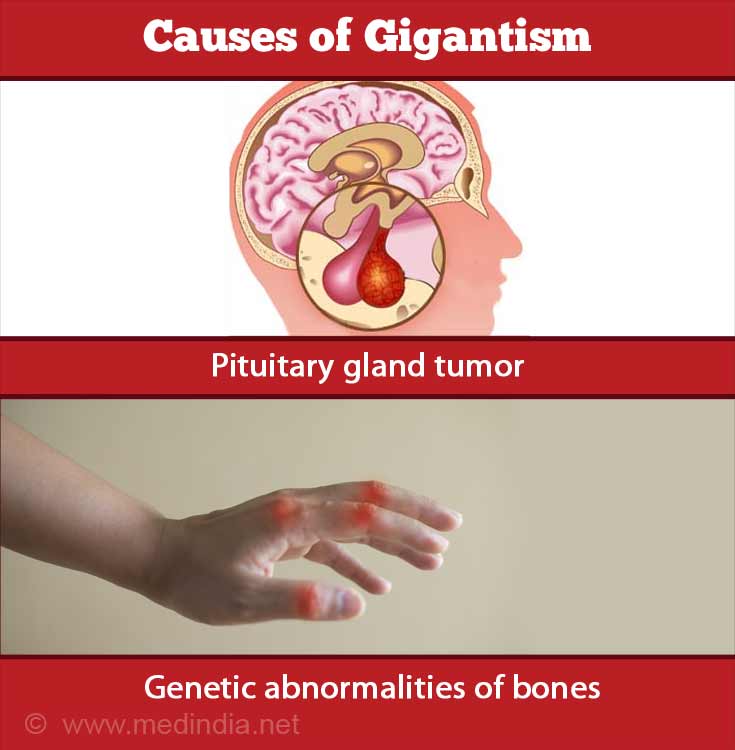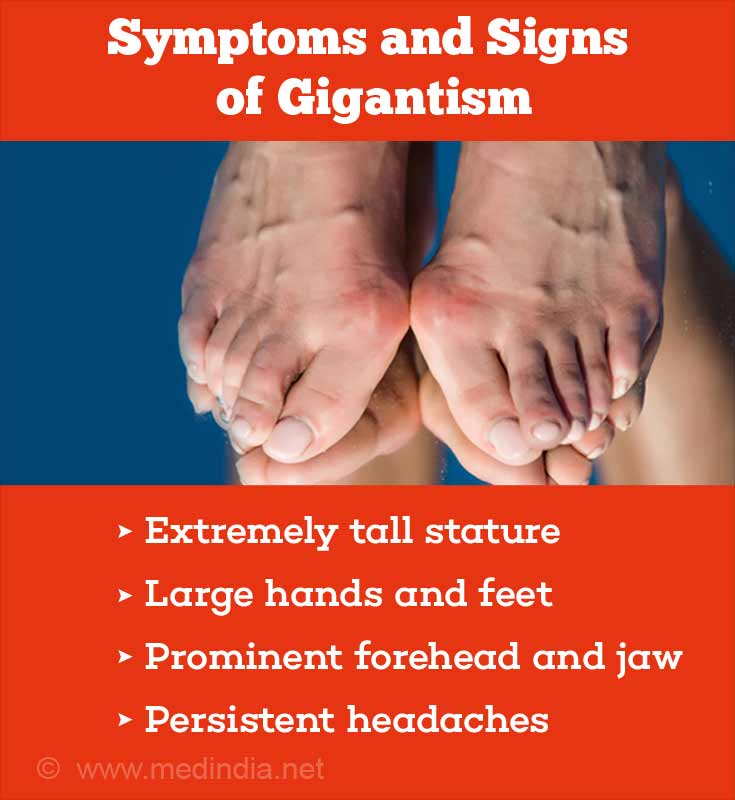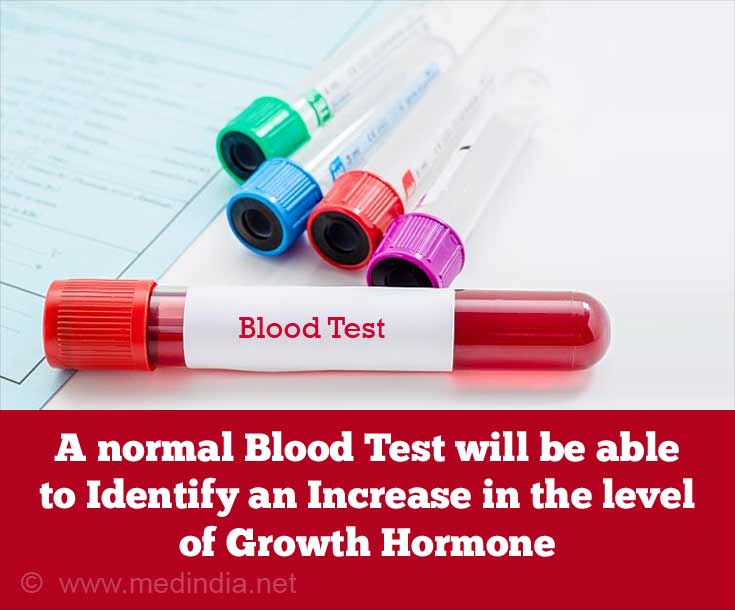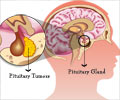- Gigantism - (https://www.mountsinai.org/health-library/diseases-conditions/gigantism)
- Gigantism- symptoms - (https://www.ncbi.nlm.nih.gov/books/nbk279155/)
What is Gigantism?
Gigantism is a rare endocrine disorder characterized by the production of excessive growth hormone (GH) by the pituitary gland during childhood. It leads to abnormally increasedF growth and extremely tall stature although body girth may also be increased. A similar condition in adults where GH excess occurs after the person stops growing is termed acromegaly and the clinical features are different from gigantism.
The function of growth hormone is stimulation of growth of bones, muscles, and several internal organs. Therefore, excess GH production leads to abnormal increase in the growth of these structures.
In gigantism, the growth hormone excess occurs while the child is still growing and the growth phase is not yet complete causing the child to reach an extremely tall stature. Also, there is increased growth of muscle and organs making the child unusually tall and large for his/her age.
What are the Causes of Gigantism?
Gigantism is an extremely rare condition. The various causes include
- Pituitary adenoma (benign tumor of the pituitary gland that secretes GH) – most common cause of gigantism
- Inherited condition causing dark spots on the skin, benign tumors of the skin, heart, and endocrine (hormone) system (Carney complex)
- Genetic disorder that causes abnormalities in bone, skin pigmentation and endocrine disorders - (McCune-Albright syndrome)
- Inherited disorder in which one or more endocrine glands are overactive or develop a tumor - (Multiple endocrine neoplasia type 1)
- Condition in which tumors arise from the nerves of the central nervous system (brain and spinal cord) – (Neurofibromatosis)

What are the Symptoms and Signs of Gigantism?
Clinical features caused by excess growth hormone production include the following
- Extremely tall stature
- Large hands and feet
- Thick and stubby toes and fingers
- Prominent forehead and jaw
- Coarse facial features – large flat nose, large lips and tongue (macroglossia) and big sized head

Most cases of gigantism are caused by a tumor of the pituitary gland. The symptoms therefore may depend on the size of the pituitary tumor. As the tumor enlarges, it may press on adjacent structures and nerves in the brain. Symptoms due to compression of brain structures include
- Persistent headaches
- Vision problems – double vision (diplopia), difficult side vision
- Deafness
- Nausea and vomiting
Other symptoms of gigantism (due to altered levels of other hormones) may include
- Excessive sweating (hyperhidrosis)
- Generalized weakness and tiredness
- Sleep disorders and disturbed sleep (insomnia)
- Delayed puberty in both boys and girls
- Irregular periods in girls
- Voice changes
- Secretion of breast milk in females in the absence of pregnancy and childbirth (due to increased prolactin levels seen in some cases)
How do you Diagnose Gigantism?
Early diagnosis is important so that treatment can begin early to slow down or stop the changes caused by excess growth hormone. However, the condition may not be easy for parents to identify as the changes may be initially mistaken for normal childhood growth spurts.
When the parents consult a doctor for persistent headaches, sleep disturbances or menstrual abnormalities in girls, the doctor will obtain a detailed report and make a thorough physical examination. Based on suspicion, further tests may be requested to confirm the diagnosis of gigantism
Blood tests
Blood test to measure levels of growth hormones and insulin-like growth factor 1 (IGF-1), which is a hormone produced by the liver both of which may be elevated. Other hormones that are measured include cortisol, thyroid hormone, prolactin, testosterone (in boys) and estradiol (in girls).

Oral Glucose Tolerance Test (or GH Suppression Test)
Thechildis given a drink containing glucose, a type of sugar. Blood samples will be taken before consuming the drink and every half hour for two hours after drinking the beverage.
Normally, growth hormone levels will drop after eating or drinking glucose. If the levels of GH remain the same, it indicates that the body is producing too much growth hormone.
Imaging tests
If the blood tests indicate gigantism, an MRI scan of the brain may be advised. The scan will help to pinpoint the exact location of the tumor and its size.
How do you Treat Gigantism?
The aim of treatment is to decrease or stop the production of growth hormone in the pituitary gland. The various treatment options available are surgery, medications and radiotherapy.
Surgery
Surgery is the preferred method of treatment when practically possible when the cause of gigantism is a pituitary adenoma. In tumors with well-defined margins, surgery is the treatment of choice to completely remove the tumor and is mostly curative. The surgeon may approach the tumor via the nose; microscopes or small cameras are used to visualize the tumor and remove it.
Medications
If the tumor does not have well defined margins or there is risk of injury to an important blood vessel or nerve, it may not be possible to completely remove the tumor by surgery. In such cases, drugs may be used to prevent or reduce growth hormone release.
- Drugs used include somatostatin (GH inhibitory hormone) analogues (similar in action) such as octreotide, lanreotide and pasireotide given as injection.
- Other agents include bromocriptine and cabergoline which belong to the class of drugs called dopamine agonists. Dopamine agonists are more beneficial in patients with pituitary adenomas that secrete prolactin (another hormone), in addition to growth hormone. These are given as oral pills.
- Growth hormone receptor antagonists (GHRA) are another class of drugs used to treat gigantism. They work by preventing one of the main functions of GH, namely stimulation of insulin like growth factor (IGF-1) by the liver. Since IGF-1 is responsible for most of the tissue overgrowth associated with gigantism, reducing IGF-1 levels may be useful. Example of GH receptor antagonists include
pegvisomant which is administered as injection
Gamma knife radiosurgery
If standard surgery is not possible, then the surgeon may recommend gamma knife surgery. The “gamma knife” consists of about 200 highly focused radiation beams. They are able to deliver a powerful dose of radiation at the point where they meet and hit the tumor. This dose is sufficient to destroy the tumor tissue. It is performed under general anesthesia.
This treatment has been linked to development of obesity, behavioral problems and learning difficulties in children and is considered only if other options fail.








